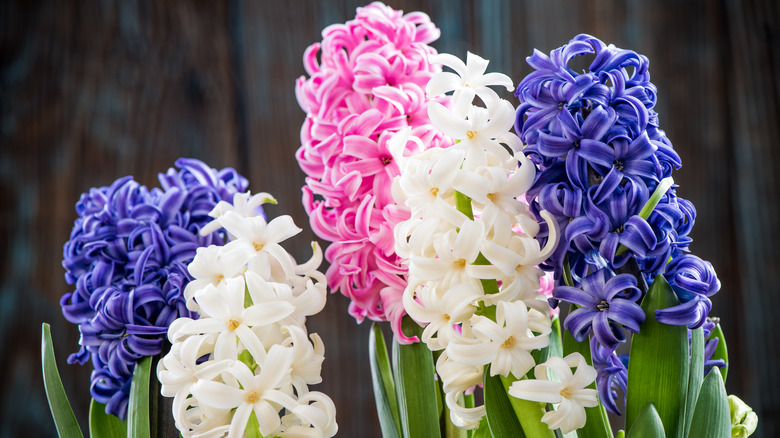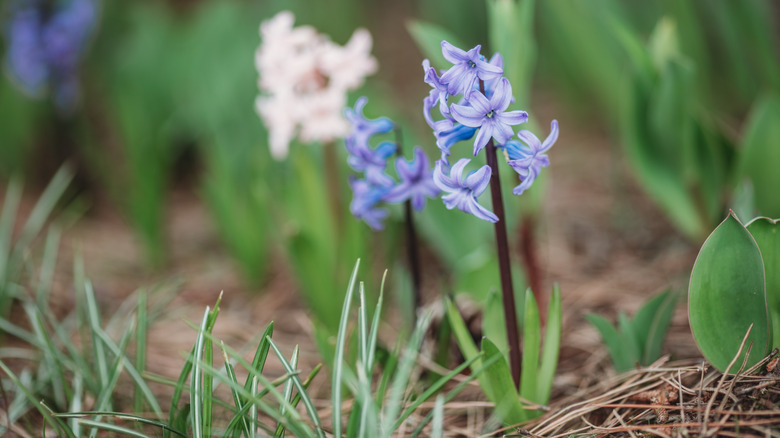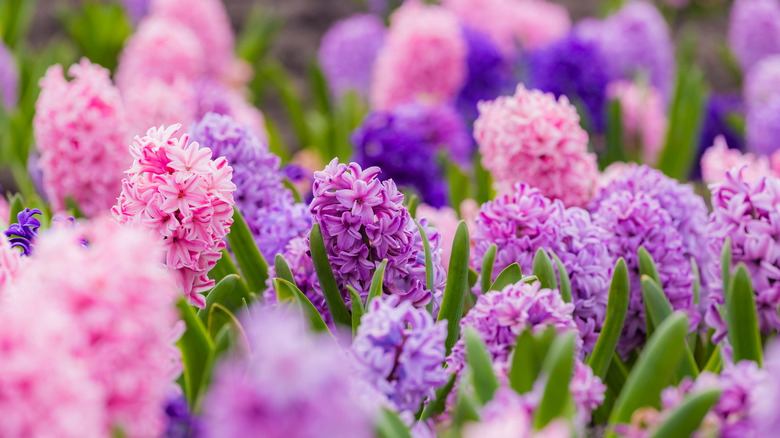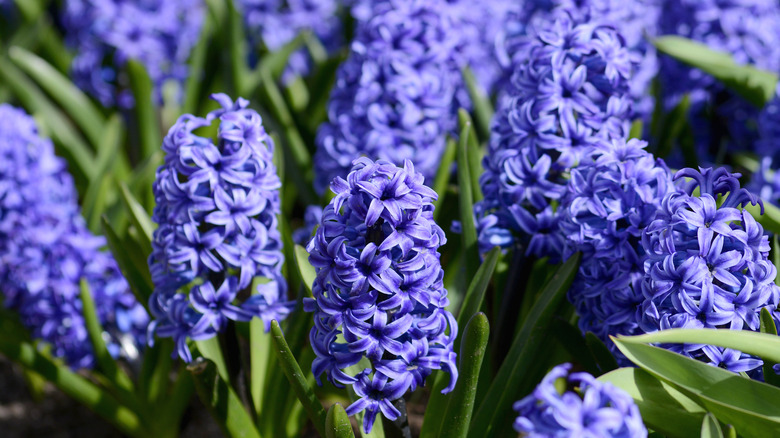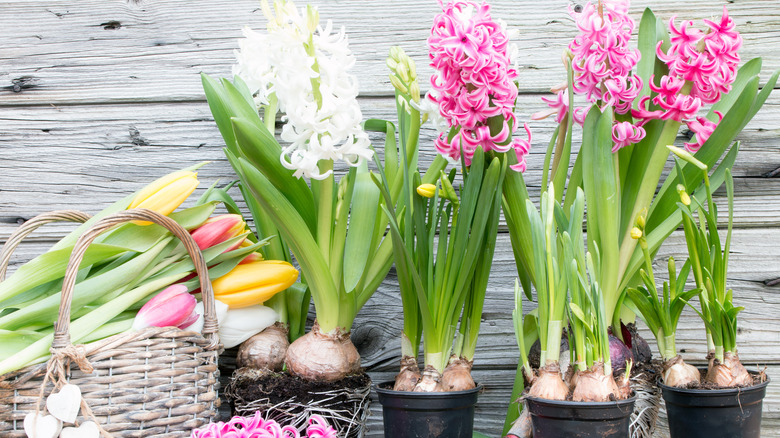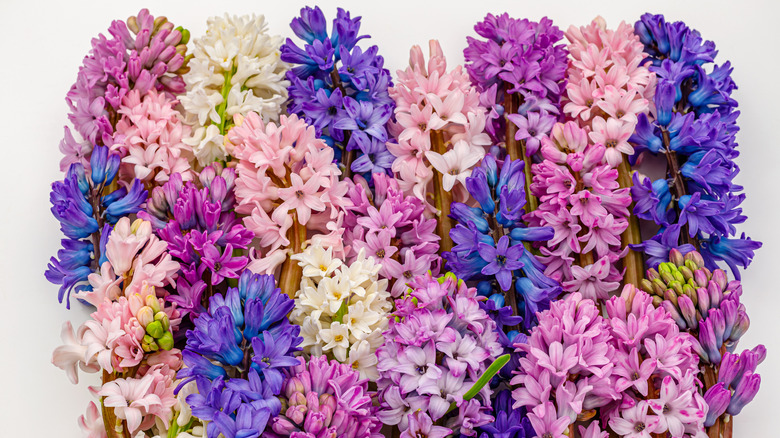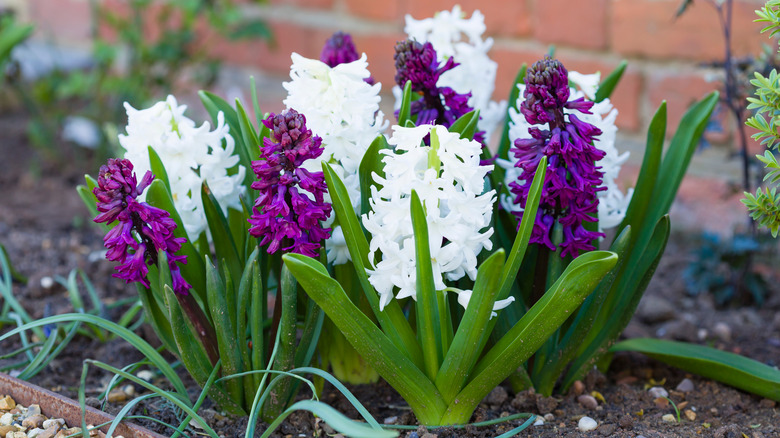The Best Way To Care For A Hyacinth Flower
Hyacinths (hyacinthus orientalis) are a popular spring flower. The flowers produce a strong and pleasant scent and come in a variety of colors, making them a beautiful addition to a spring garden. Hyacinths have come to be known as a symbol of jealousy and sorrow, particularly yellow hyacinths, warns Florgeous. Different colors symbolize different emotions and affections, though — blue means sincerity, white symbolizes prayer, and purple represents sorrow and forgiveness.
These flowers are well known for their role in Greek mythology. Lovingly summarizes the myth of hyacinths, in which the sun god Apollo competed with the god of the west wind, Zephyr, for the affections of Hyakinthos. Hyakinthos was throwing a discus with Apollo when Zephyr sent a gust of wind towards the pair, causing the discus to kill Hyakinthos. The hyacinth flower grew from Hyakinthos' blood. Hyacinths also are a favored topic of symbolic discussion in T.S. Elliot's poem "The Waste Land," due to his repeated reference to the "hyacinth girl," thought to be referencing the Greek myth.
The perennial hyacinth is an excellent addition to a garden for a vibrant pop, grows in most of the U.S., and is a popular option for a reason. Read on to learn how to care for these fragrant flowers.
How to use hyacinths in garden
Hyacinths are an excellent addition to your garden. The perennial flowers will bloom in the early spring, producing an array of colors and a sweet, floral aroma. Hyacinths grow best in USDA hardiness zones 4 through 8, though they can be grown in warmer climates by pre-chilling the bulbs, advised Longfield Gardens.
While hyacinths make a gorgeous stand-alone addition to a garden bed, they can also be planted along with other beautiful spring flowers. Better Homes and Gardens lists a few popular spring companion plants and flowers to plant along with hyacinths, such as daffodils and tulips. Ensure the variety of flowers you're choosing are also early-spring bloomers, so you get the full effect.
Also, consider using hyacinths as an accent in perennial ground cover plants, such as thyme and stonecrop. Plant a variety of hyacinth colors for a dramatic, colorful landscape. Plant hyacinths in groups of 10 to 15 bulbs for the best results.
How to grow hyacinths
Hyacinth flowers are most commonly grown from bulbs purchased at a garden center during the flower's planting season. According to The Old Farmer's Almanac, hyacinths are best planted after the first fall frost but before the ground is frozen. Hyacinths should be planted in an area where they'll receive full sun, but they'll survive partial shade. Also, ensure the soil where you plant the bulbs is well-draining and that water doesn't pool or collect. Before planting, consider adding compost, bonemeal, or other organic material to the soil.
To plant bulbs, begin by digging a hole 5 to 6 inches deep for each bulb, roughly 5 inches apart (plant deeper in colder climates). If your bulbs do not have stems yet, plant with the pointed side facing the sky. Cover with soil, then water. Consider mulching around the flowers to help with moisture regulation and weed control.
How to care for hyacinths
Hyacinths are perennial flowers, meaning they grow back every spring. Taking care of these flowers will result in continuous yearly blooms, so long as their growing conditions are maintained. Hyacinths prefer full sun, six to eight hours a day, according to The Spruce. They can survive in partial shade, but their blooms may not be as full. Their soil should be well-draining, as hyacinths don't like sitting in water or wet soil. Adding organic matter (compost, bonemeal, etc.) can help with their blooms, but too much can overwhelm them and cause them to droop.
Hyacinths should only be watered if the soil is completely dry. Rainfall should be enough to maintain their moisture conditions, but take care to check the soil during long periods of no rain. Hyacinths will survive most winters, but people in warmer climates may want to dig up their bulbs and keep them refrigerated for the winter months. Mature hyacinths can sometimes grow too tall to support their weight, so consider staking them if they start to droop.
How to repot hyacinths
While hyacinths are commonly planted in the ground due to their climate versatility and yearly regrowth, some may find better luck growing their hyacinths as container plants. This is helpful for people in warmer climates who need to chill their flowers over the winter, keeping them away from pets and small children, or simply for those who prefer the look of a container garden. SFGate recommends repotting hyacinth bulbs roughly every three years.
Replanting hyacinths should be done after the plant goes dormant, which will be roughly after six to 10 weeks of blooming (in early to mid-summer). Begin by removing any dead leaves with clean garden or pruning shears. Remove the bulbs from the pot and gently remove as much old soil as possible. Use a towel or cloth to gently clean off the rest of the dirt. Assess the bulb, and look for any offshoot bulbs. Remove these.
Prepare the hyacinth's pot. The same pot is fine; just ensure there's enough space for all the bulbs you wish to plant. Add well-draining soil, and then your bulbs with the pointy side up, a couple of inches below the soil. Water thoroughly and expect blooms the following spring!
Hyacinth varieties
One of the major draws of hyacinths is the number of varieties they boast. They can be tall or short, full and bushy or thin and stemmy, and come in an array of colors. Yet, their care needs are remarkably similar, meaning you can plant multiple hyacinth varieties in your garden for a beautiful assortment of blooms. Here are just a few of those varieties, according to The Spruce:
- 'Blue Jacket' hyacinth: As the name suggests, this variety is a rich, dark blue-purple shade with a dense bloom arrangement.
- Hyacinth 'Pink Pearl': The 'Pink Pearl' is a pink variety, getting its pearlescent comparison from the flower's dark pink leaves with a light pink, almost white, border.
- 'Woodstock' Hyacinth: This stunning variety is identifiable by its unique dark plum-colored flowers.
- Hyacinth 'Hollyhock': The 'Hollyhock' variety boasts a dense but thinner cylindrical bloom structure and a deep reddish-pink color.
- Hyacinth 'Top White': This variety is unique for its bright white flowers, which bloom in star-shaped petal patterns.
Are hyacinths toxic?
While hyacinths are beautiful spring flowers, they are also toxic to cats, dogs, and horses, and can be a skin irritant to humans. The ASPCA lists hyacinths as toxic, listing symptoms such as vomiting, bloody diarrhea, depression, and tremors upon ingestion. Pet Poison Helpline says the poisonous part of hyacinths is concentrated in the bulbs (though all parts of the flower are toxic for pets), and poisoning cases most often result from dogs digging up and eating bulbs. This results in severe hyacinth poisoning, which starts with irritation to the mouth and throat (vomiting, drooling, diarrhea, etc.) and can lead to increased heart rate and difficulty breathing. Contact your vet immediately if you suspect your pet has ingested hyacinth and is displaying symptoms.
Hyacinths are not edible to humans, but they aren't necessarily poisonous (though you should keep curious children from eating the plant). However, the bulbs release crystals of calcium oxalate, which can cause skin irritation (via Gardening Know How). Not everyone is sensitive to calcium oxalate crystals, but those who are will experience mild to severe itching and possibly rashes. Take care to wear gloves when handling the bulbs. If you get a rash or itch, wash your hands with an antibacterial soap. Consider using an antihistamine if the itch takes longer than usual to go away.
